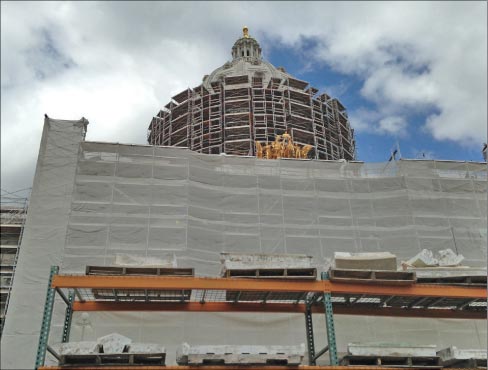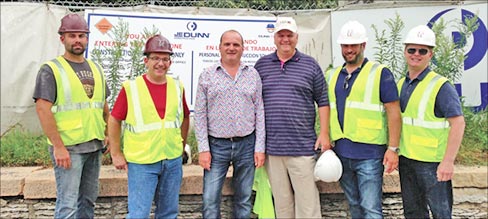Minnesota State Capitol Restoration Features Several MIA Members
 |
 |
|
Above, From Left: Steve McIntosh and Joe Becker (Twin City Tile & Marble Company), Patrick Perus (Polycor), Bernie Van Etten III, Joshua Levinson (Artistic Tile), and Michael Schlough (Park Industries) joined Jim Hieb (not pictured) on the tour. |
Past MIA president Monica Gawet (Tennessee Marble Company) recently stated: “There are many firms here in the US that do outstanding commercial stone work.” The Minnesota State Capitol Building restoration project certainly highlights that sentiment.
This is the first comprehensive preservation of the Capitol building since its original construction in 1905. The exterior of the building is Georgia White marble. It is a $272.7 million, three plus-years restoration and renovation project featuring historical lighting fixtures, marble repair and restoration, as well as other interior and exterior upgrades. For the stone component, several MIA members are involved: Bonstone, Italmarble Pocia, Polycor, Tennessee Marble Company, Twin City Tile & Marble Company, and Cutting Edge Stone.
Twin City Tile & Marble Company was the lead MIA member onsite with responsibilities including: field measure of all stones; shop ticket creation and coordination with architects (HGA and WJE); creating full size models of carved elements for use by the fabricators; stone acquisition; and, working with field carving of new stones to match existing profiles.
Joe Becker, Twin City Tile & Marble Company, serves as the overall project manager. He indicated: “Projects like this one are a ‘once-in-a-lifetime’ opportunity. The combination of restoration/fabrication being done using modern technology, coupled with hand-precision of our store carvers is just remarkable.”
Gawet commented that the complexity of this project is worthy of a broader case study. She added: “There were hundreds of cut pieces on the project varying in shape, length and thickness. While molds were primarily cut on a CNC, many required hand cutting returns in the shop. Because there were a limited number of repeat shapes or sizes, the CAD/CAM programing was time consuming as well.”
Polycor’s Sylvie Beaudoin was the project manager coordinating all the raw material selection, fabrication details and delivery schedule requirements to the fabricators involved.
In many respects she made the project run smoothly and efficiently prior to the onsite field work.
Becker and Steve McIntosh (project manager for field measurement efforts and management of the day-to-day onsite operations) recently led a small tour for the Marble Institute of America (MIA) to showcase the type of stone work that many in the stone industry never have a chance to see first-hand.
High up in the scaffolding of the building, the complexity of the project was evident. The role of the “old world” craft of three stone carvers displaying their trade, each beaming with pride that their work will help preserve the building at least another 100 years, was also a highlight of the tour.
The amount of training each had was equally impressive. With a “master stone carver” certification, Mark Wicksrom studied for two years in France with the French Stone Mason’s Guild, and also participated in a one-year study program carving at the Notre Dame Cathedral of Reims. Margaret Moore is a graduate of the American College of the Building Arts in Charleston SC. She trained with Simeon Warren, as well as under a German Master Carver, Frank Haufe. Her resume includes work on the Lincoln Cathedral Works department. Scott Halverson has been carving stone since the mid-90s and is a Professional Member of the Stone Carvers Guild. He has also been mentored by store carvers associated with the Elisabet Ney Sculpture Conservatory.
Becker commented: “It is wonderful that the stone carving craft is still available and their skills compliment what we had fabricated by machine in Georgia, Tennessee, and Italy.”
The Capitol is on schedule to be fully reopened for the 2017 session, with some minor restoration work continuing until later that year. Look for an expanded article about this project in the next issue of the Slippery Rock Gazette.